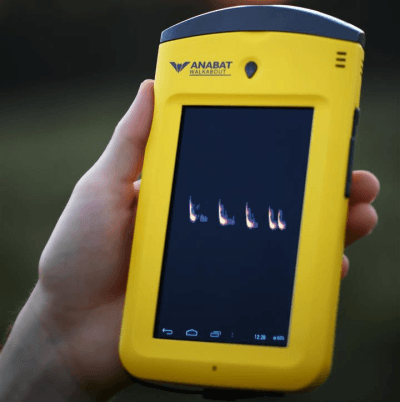The SM4BAT is the latest SongMeter system, available in both full-spectrum and zero-crossing models, from Wildlife Acoustics.
It is a ultrasonic bat recorder,designed to be used as a passive/unattended recording solution.
It's a single channel recording system, which is both lightweight and compact. I can also tell you, that no less than 9 of them will fit into an ordinary backpack.
As per Wildlife Acoustics' Web site: "The new, low-power microprocessor, combined with 4 D-size batteries, enable the longest deployment times of any other bat recorder available. The SM4BAT FS has a recording run time of 250 to 450 hours (e.g. 25-45 10-hour nights) depending on bat activity and other factors."
There are several features which make this bat detecting system desirable: It's particularly well-suited for those in need of unattended monitoring/recording of ultrasounds; especially bat activity. It is capable of recording an unprecedented number of bat passes - up to45 nights! directly across multiple (up to 2) SD cards. It's very easy to use, and no PC is needed for the set-up, or actual recording.
As always, the Customer Service/Support aspect of Wildlife Acoustics: In a nutshell, their Technical Support is second to none.
This new SM4BAT FS has proven to be excellent for my nightly recordings.Another neat attribute of the SM4BAT I like, is how the microphone units are protected. Using a well-secured, dark gray foam.
In the printed materials provided, Wildlife Acoustics explains just how waterproof their SM4BAT platforms are. As in the past, they also provide tips and best practices for outdoor deployment.
The SongMeter SM4 has been designed with great pick-up range. There is a PCB mounted, 3.5mm earphone jack located inside the SM4BAT's enclosure. This is provided so that one can listen to the sound input while recording; this may be used for live monitoring, to check the status of microphone(s), perform test recordings, etc.
No tools are required to open the unit.
With the top cover snapped back on, in preparation for mounting/deployment - The green LED light will be visible to you, via a built-in diffuser. So that you can get feedback before, during, and after the unit is mounted:
- A steady, repeated blinking: Indicates the unit has started it's scheduled recording. This informs you that the system is awake, and is actively monitoring.
The installation and configuration of the SM4BAT is a very easy process.
Just install batteries - 4 D cells (Energizer brand recommended), a Class 4 SD memory card, and you're more than halfway done.
Some of the other main features are: The LCD display - Which is easy to read, and will help you set all device options.
Among the main things you might want to do are:
- Set the Record Start and Stop times, set the internal clock.
- Adjust Sensitivity values which you can use to fine-tune the level for the triggering.
There are a few other things, which you will learn all about from the User Guide; which happens to be one of the best I've ever seen.
It has been a pleasure to use. And thanks to Wildlife Acoustics' Kaleidoscope software: The analysis of bat recordings has been a breeze ever since! I've got lots of recorded bat calls to listen to, and create various sonograms with.
The SM4BAT happens to be the approximate size of other comparable unattended recording solutions. In fact, it is a bit smaller than some. It is easily portable, fitting one (along with accessories, etc.) into a backpack is effortless. Without batteries installed, the unit is very light. As previously stated - The fact is, you can fit 9 of these units in a typical backpack (with room to spare).
Sensitivity and filtering are fully adjustable, across the spectrum of the unit's abilities.
The fact that the unit can be used as a "Set-and-forget" recorder (for up to 45 days) is a plus.
The unit is very economical; especially when compared to the similar systems that are currently available.
The Kaleidoscope software, from Wildlife Acoustics is very versatile; and produces nice-looking (and informative) sonograms.
With the great help/suggestions and support I received from the Folks at Wildlife Acoustics, I ended up with a diverse collection of recordings. The nice thing about it, is that I was able to test a lot of different variations of settings. In a short period of time.
You can basically go either way, in your approach to the use of this system: You may choose to rely mostly on the default settings - And take a more simple approach (which is exactly what I did in the beginning of the test period). Or, you may be the type who enjoys tinkering & experimenting.
Happy bat detecting!





